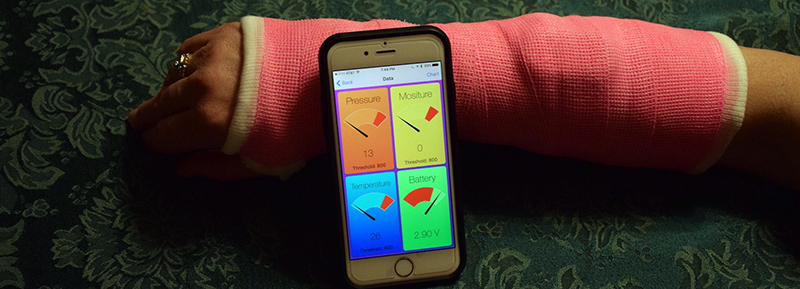[Alex]’s entry for the Hackaday Prize is extremely simple: it’s a device to monitor the inside of casts. For every itch, for every broken bone, for every skin irritation, and for every episode of House that featured compartment syndrome, the CastMinder has an answer.
The CastMinder is a simple electronic device embedded inside an orthopedic cast. Attached to this tiny bit of electronics are a few sensors, relaying pressure, moisture, temperature, and of course the battery level to an iOS app. The use case for this device is actually very simple; the pressure sensor is a great idea if you have a cast and you’re unconscious in a hospital. A moisture sensor will at least tell you how many trash bags wrapped around your broken arm are necessary to take a shower.
The entire device is based on the LightBlue Bean, a tiny Bluetooth-enabled device that can be powered by a CR2032 battery. The enclosure is 3D printed, and the entire device is small enough to be embedded in a cast without the wearer noticing much. It’s a great idea, and a great project to make it to the semifinals of the Hackaday Prize.




















The “the CastMinder has an answer.” link doesnt work.
Just to let u know.
Seems to be fixed
Great idea! My only critique would be the constant bluetooth connection, limiting battery life on the medical device and the phone. If you don’t need the data until you look at the app, you could use the app as a portal to activate the phone’s bluetooth and connect to the cast. The cast device could then poll the sensors, updating the app. It might take a moment longer to receive updates, but would drastically extend the battery life of both devices. Adding a “pair” button to the outside of the cast device would allow it to stay off until button is pressed, then turn on, present a bluetooth interface to connect to, then poll the sensors while the phone app is connecting. Some phones with NFC may allow you to use an RFID chip to activate the bluetooth connection and poll the sensors simply by waving the phone over the cast tri-corder style
My point is, most casts are worn for at least 6 weeks. Unless you’re using wireless charging, I don’t see the batteries lasting as long as the cast. In a hospital setting, device could (and should) remain plugged in.
Hey Jake,
I’m Alex, the creator of this project. Thanks for your comments. I’ve actually done quite a bit of experimentation with the battery life of a CastMinder sensor node and having wires underneath the cast. My initial concept was to have a bunch of sensor nodes wired together that communicate to a host device via i2c. The host device would be outside the cast, have a rechargeable battery, and have a Bluetooth chip that sent data to the same iOS application. I had problems keeping the wires from breaking or strangling the user under a splint (casts were ok), so I had to throw that idea out. The Bluetooth board I’m using, the LightBlue Bean, is actually really good at saving power. There’s an amazing sleep function that turns off basically everything on the board. In my tests, the battery life should be just enough for the duration of the cast. If not, I can also drastically extend the battery life by wiring a bigger battery next to the board.